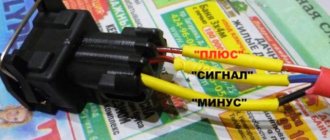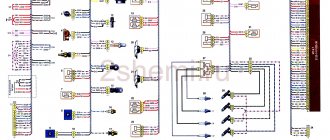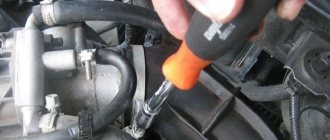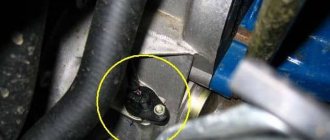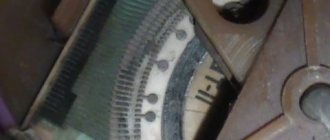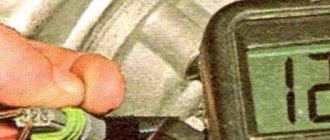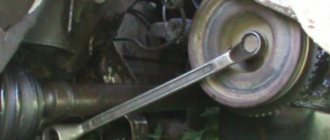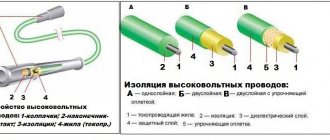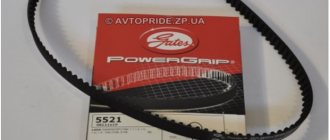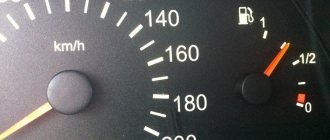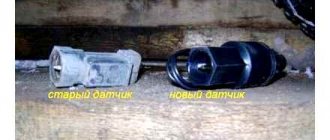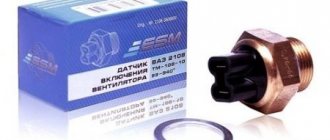Speed sensor VAZ 2115
You discovered that your VAZ 2115 car began to stall at idle, “floating” speedometer readings appeared, engine thrust dropped, and fuel consumption increased - all this means that the speed sensor is acting up. Replacing the speed sensor of a VAZ 2115 is not difficult. It is enough to know where it is located and how to get to it. The procedure will take very little time and will save you money, and our instructions will help you. Let's start in order.
Features of replacing the speed sensor on VAZ-2113, 2114, 2115
The main role of the speed sensor (DS) is to obtain information about the number of revolutions transmitted from the gearbox gears to the front wheels of the car, as well as transmitting this data to the electronic control unit (ECU).
The controller processes the received information and transmits it to the control panel, thereby informing the driver about the speed of movement and the distance traveled. In addition, based on the same information, the ECU calculates the required proportions for the fuel mixture supplied to the engine cylinders.
There may be two types of speed sensors in VAZ 2114 cars:
- a sensor with a mechanical drive from the gearbox gear and a cable drive of the speedometer (has a side outlet for wires and a seat for the cable);
- sensor with mechanical drive from the gearbox and electronic connection to the controller;
The speed sensor is located on the rear of the engine on top of the gearbox housing.
Functionality check
Diagnostics of the performance of the DS can be done in two ways.
The first option, to implement it you will need a multimeter:
- First you need to dismantle the controller itself. Read more about the removal procedure below.
- Then the tester should be set to alternating voltage mode.
- After this, you should close the multimeter probes to the contacts on the controller plug. The first probe should be connected to the contact that goes to the dashboard, it is located in the center, and the second - to ground, that is, the car body.
- There is a special rod in front of the controller; when it rotates, the device starts. That is, to diagnose the functionality of the regulator, the rod should be rotated; to do this, a metal tube of the same size should be installed on it; this option is more convenient.
- When the rod begins to rotate, the multimeter display will display data on alternating voltage, or rather, its surges. Moreover, the higher the rod rotation speed, the larger the jumps in values will be. This voltage does not jump, this indicates a controller malfunction.
The device can also be checked without dismantling it, but to implement this method, you must drive your “Fifteen” onto an overpass or pit:
- When the car is in the pit, you will need to jack up the front left wheel.
- Next, you need to find the controller itself, which is located on the gearbox, and then disconnect the connected wiring from it.
- Then take a multimeter and connect its probes to the ground contact, as well as transmitting the impulse to the control unit, this is the central, as well as the outermost contact on the block.
- Now you need to rotate the jacked wheel and diagnose the values that the multimeter gives for the appearance of voltage surges. If you don’t have a tester, you can use a regular test lamp with wires connected to it. One of the wires should be connected to the left contact, that is, power, and the second to the central one. If the light source starts to blink when the wheel rotates, this indicates that the DS is working properly.
Perhaps the reason the DS is not working is poor contact with the car's electrical network, then you will just need to clean or replace the contacts. Before diagnosing, carefully inspect the device; if there are serious signs of damage on it, then there may be no point in even checking it (the author of the video is the REMONTYCA channel).
Malfunctions
Signs of a broken DS are:
- incorrect speedometer readings (chaotic needle movement);
- problems with the engine idling;
- error message (code 0500, 0501);
- “floating” speed;
- “failures” during acceleration;
- increased fuel consumption.
DS malfunctions include:
- lack of contact in the connector;
- sensor wiring break;
- breakdown of the mechanical drive of the sensor;
- failure of the sensitive element (for electronic DS).
After checking the contacts and wiring and making sure that everything is in order, you need to remove the sensor from its seat and replace it with a new one. If the sensor is not replaced, the ECU will “force” the engine to operate in emergency mode, which will lead to increased fuel consumption, as well as wear and tear on other elements of the fuel system.
The speed sensor itself is inexpensive: mechanical versions cost 300-500 rubles. Replacing it at a service station will cost approximately 200-300 rubles.
However, it is not necessary to overpay for the work. The speed sensor can be easily replaced independently in 15-20 minutes.
When purchasing a DS, you need to pay attention to its manufacturer and the material used to make the rod. A rod made of plastic may fail after just a few days. By the way, if the rod falls apart, you will have to disassemble the gearbox.
DIY replacement instructions
The procedure for replacing the DS with your own hands looks like this:
- First of all, you need to turn off the ignition and open the hood.
- To make the repair procedure more convenient, you can dismantle the adsorber. To do this, you simply need to unscrew the nuts that secure this unit, and then remove it to the side. Completing this step will take literally 1-2 minutes, but it will greatly facilitate access to the device.
- After this, you need to tighten the fastener and remove the connector with wiring.
- After completing these steps, you can begin dismantling the device. You need to turn the device counterclockwise until you completely unscrew the DS. Remove the DS from the seat; for this you will need a 21mm wrench.
- The installation site of the DS must be cleaned of dust and dirt to prevent it from getting inside.
- Next, a new DS is installed; in this case, you must act carefully. The bottom line is that the controller body is made of plastic, so even minor mechanical impacts can lead to its failure. Mount the DS into the mounting location so that its grooves completely coincide with the bushings, otherwise you will not be able to securely fix the device in the installation location. Turn the DS clockwise until you feel resistance. There is no need to tighten the device too much.
Self-replacement of the sensor
- Raise the hood and turn off the power by removing the ground terminal from the battery.
- For ease of operation, remove the air duct corrugation.
- When access to the sensor is open, disconnect the wires from it.
- Turn the sensor body counterclockwise by hand and unscrew it.
- If you suspect a malfunction of the drive, unscrew the nut securing it with a 10mm wrench and pry off the drive housing with a slotted screwdriver.
- Carefully remove the drive.
- Install the new drive and secure it.
- Install the new sensor and connect the wires.
Replacement
To replace the meter yourself, you must first remove the air filter housing. Then, using a wrench, you need to unscrew the sensor counterclockwise; quite often the sensor can be unscrewed without force by hand.
After dismantling the old sensor, you can install a new one, making sure to align the sensor pin with the grooves in the speedometer drive.
The part can be replaced at a car service center by professionals. They have all the necessary equipment and skills to carry out the complex procedure of replacing a critical part.
Vehicle speed sensor VAZ 2115
Some car sensors and sensors only manifest themselves in the event of a breakdown. For example, the operation of the VAZ 2115 speed sensor is invisible during operation. Many drivers do not know that in addition to speedometer readings and mileage tracking, this device performs several more functions:
- Idle speed is adjusted even when the car is moving, based on speed readings;
- control of air supply bypassing the throttle assembly;
- When the throttle valve is closed, the engine control unit receives signals from the speed and crankshaft speed sensors.
Characteristic
Where is the speedometer sensor located in the VAZ 2115? As can be seen from the photo, the device is located in the upper part of the gearbox housing. However, accessing this controller is not very easy. To get to the device, you need to drive the car into a pit or overpass and crawl under the bottom of the car.
Functions and principle of operation
The purpose of the speed controller in injectors and carburetor engines is to transmit information about the vehicle speed to the dashboard. That is, the working sensor will be able to transmit 100% accurate information about the speed of movement to the device so that the driver can be guided by these data while driving.
As for the operating principle, the DS operates based on the Hall effect:
- the controller transmits voltage signals to the control unit with a frequency that should be directly proportional to the speed of rotation of the driving wheels of the vehicle;
- the control unit, in accordance with the received DS signals, regulates the operation of the power unit at idle speed and, using the idle speed sensor, controls the air supply bypassing the throttle;
- the frequency of the controller pulses itself should be directly proportional to the actual speed of movement.
Errors and symptoms
What signs can be used to determine the failure of the controller or the appearance of malfunctions in its operation:
- during diagnostics, error P0500 occurs - this combination indicates that there is no signal coming from the DS;
- another code - P0503 - indicates that the incoming signal is interrupted for some reason;
- one of the most likely signs of a breakdown is that the speedometer shows incorrect values, in particular, the needle on the dial moves chaotically in different directions;
- another symptom - the car engine began to idle intermittently;
- at idle speed fluctuates;
- Also, during acceleration, the driver may notice failures, that is, when he presses on the gas, there is no gain of power, the engine does not react to this in any way;
- fuel consumption has increased.
As for the malfunctions themselves, the speed controller may fail for the following reasons:
- there are no contacts between the device and the on-board network;
- there was a break in the electrical circuit of the regulator;
- another reason is a malfunction of the mechanical drive of the device;
- as a result of wear or damage, the sensitive element of the controller could break, in particular, we are talking about electronic devices (the author of the video is the Glaz Szalg channel).
Design and principle of operation
The sensor is a complex of mechanical and electronic components operating according to the Hall principle.
The rotating parts convert the electrical signal into a chain of pulses that are multiples of the rotation of the sensor axis. Due to the mechanical connection of the sensor rod with the wheel hub, the rotational movement of the wheel is converted into the distance traveled.
- when the outer surface of the tire rotates 360°, the wheel moves horizontally a certain distance;
- this path is equal to the circumference of the tire, it is programmed into the engine ECU;
Important: Installing wheels of a non-standard size disrupts the operation algorithm of the VAZ 2115 speed sensor.
Both of these parameters are involved in the coordinated operation of the engine's electronic control unit.
What happens if this sensor breaks?
Of course, the car will not stall, and you can continue driving it, but only to the place of repair.
- Absence or incorrect readings of the actual vehicle speed. The speedometer needle “hangs” at one mark, moves chaotically, or does not deviate from “zero” at all.
- On a moving vehicle, when the accelerator is released, interruptions in idle operation are observed.
- Floating idle speed when stopping.
- Unreasonably high fuel consumption.
- During intense acceleration, dips in traction occur: there is no increase in power in proportion to pressing the gas.
Speed sensor - signs of malfunction
During operation of a car of absolutely any brand, some parts can break, sometimes this happens with the speed controller. Problems with it on the fifteenth VAZ model are not a very common breakdown, but it can still happen from time to time.
The trip computer can indicate a malfunction of the speed sensor by generating error codes:
- Code P0500 - indicates that no data is being received from the speed sensor;
- Code P0503 means that the signals are interrupted.
Other signs may also indicate the above problem:
- Unstable operation with subsequent breakdown of the speedometer. It all starts with the needle on the dial twitching chaotically.
- Reduced engine power.
- Fuel consumption is too high.
- Changing the engine speed.
Of course, the above problems can indicate not only problems with the speed sensor, but, as experts say, in these situations it is checked first.
Where is the speed sensor located and why does it break?
The sensor is located on the gearbox housing, in its upper part. To get to it, you need to lift the car on a lift, or use the inspection hole.
The device and its electrical wiring are affected by moisture, road reagents and temperature changes. The causes of the malfunction are the following:
- breakage of connecting wires;
- corrosion of the connector terminal block;
- mechanical failure of the rotating rod;
- failure of the electrical part.
The symptoms of any of the breakdowns are the same; the sensor itself cannot be repaired: only replaced. Only oxidized contacts or broken wiring can be restored.
How to check
First of all, we carry out a visual inspection. The wires must be intact and have no obvious kinks or damage to the insulation. The cleanliness of the contacts on the connector is also checked. After inspection, we check the electrical part of the device.
- You can jack up one of the front wheels of the car and spin it with the ignition on (we don’t start the engine). Voltage surges are checked using a multimeter at the information contact (central terminal).
- If you remove the sensor, you need a device to force the rod to rotate. A voltage of 12 volts is supplied to the power terminals, the tester is connected to the negative terminal and the signal contact. When rotating, we register impulses. If they are not there, the sensor needs to be changed.
To replace, you will need a 21 key. We replace the faulty part with the negative terminal of the battery reset.
Advice: You should not save money by buying a cheap sensor from a dubious manufacturer. A branded part is not so expensive that you risk a breakdown on the road, where there will be no way to diagnose and replace the speed sensor.
Self-replacement of the VAZ 2115 speed sensor
You discovered that your VAZ 2115 car began to stall at idle, “floating” speedometer readings appeared, engine thrust dropped, and fuel consumption increased - all this means that the speed sensor is acting up. Replacing the speed sensor of a VAZ 2115 is not difficult. It is enough to know where it is located and how to get to it. The procedure will take very little time and will save you money, and our instructions will help you. Let's start in order.
Principle of operation
The operating principle of a modern speed sensor (hereinafter DS) is based on the Hall effect:
- The speed sensor transmits voltage pulses to the controller with a frequency directly proportional to the speed of the drive wheels.
- The controller, based on sensor pulses, regulates engine operation in idle mode, and with the help of the IAC (idle speed controller) controls the supply of air bypassing the throttle valve.
- In this case, the frequency of the DS signals is directly proportional to the actual speed of the car.
- DS differ in the connecting connectors to the harness block.
- BOSCH systems use a square connector.
- The sensor, which has a round connector, is used in systems such as GM and January 4.
- All of these sensors are six-pulse; they produce six pulses per axis rotation.
- A ten-pulse sensor is found in Samar carburetor trip computers.
Signals from the speed sensor are used by the control system to calculate fuel shut-off thresholds, and to electronically force limit the speed of the machine (in modern control systems). When installing the speedometer drive in models that still have one in the box, you need to be very careful, otherwise, when misaligned, the fragile plastic teeth on the speedometer drive drive gear will be crushed and then you will have to completely disassemble the entire gearbox (to replace the broken drive) and the cost of the issue increases . The output voltage for a low pulse level is permissible no more than 1 V, and for a high level it must be at least 5 V.
The main causes of DSA malfunction
The main problem that causes the signal from the speed sensor to disappear is poor contact or its complete absence. As a rule, the reason lies in a broken wire or a damaged connector, so if you notice problems with the speed sensor, first check the above elements. Check the resistance in the ground circuit, it should be within 1 ohm. If the fault was not found, check the VAZ 2114 speed sensor in more detail; read how to do this below.
How to check the DSA yourself? Ways to check the speed sensor at home
The first thing you will have to do is remove the speed sensor. The VAZ 2114 speed sensor has three contacts: 1 - ground, 2 - pulse signal, 3 - current voltage. Checking the DSA is not difficult, you need to check the ground on the 1st contact, then make sure there is voltage on the 3rd contact (should be 12 V), and finally, you should check the pulse of the 2nd contact, while rotating the drive wheels . The rotation speed must be at least 3-5 km/h. In addition, the 1st and 3rd contacts can be called.
An alternative way to check the DSA at home (without removing the DSA)
- Jack up the front wheel (if you have a front-wheel drive car).
- You need to connect a voltmeter to the sensor contacts and spin the wheel as much as possible, after which you can take readings from the device. If during the test you find that the voltage and frequency increase, the sensor is most likely working.
Types of installed meters
Replacing a speed sensor with your own hands for a VAZ 2115 is not much different from replacing it on any car of the “tenth series” (for example VAZ 2110-2112), as well as the Samara series (VAZ 2113-2115), and new products such as Lada Kalina , Grant or Priora. The sensor itself is located on the rear side on top of the gearbox (when viewed from the radiator) directly above the differential, where the wires come out (in the photo below it is shown by an arrow, look under the pipes).
The meter we are looking for is located under the pipe indicated by the arrow.
At different times, three types of sensors (meters) were installed on VAZ models. The first of them is no longer used on new cars.
Type No. 1
Installed on the first Samaras with an injector with a cable-driven speedometer:
- It was installed as an “intermediate insert” between the speedometer cable and the gear output to the gearbox.
- Wires with a connector extend from it to the side.
Speed meter of the first (oldest) type
- Its malfunction can only be determined with a special diagnostic tool at the same speed at idle. And also when the car is coasting and when stopping.
Sometimes, when such a breakdown occurs, the car begins to stall immediately after engaging the “neutral” (neutral gear) while driving. This happens due to the fact that the car, when driving, maintains a slightly higher idle speed initially (1000 instead of 850 if the car is stopped). This is designed for smooth shifting when coasting from neutral to gear.
Attention: Before replacing, it is recommended to check the drive mechanism (on which the meter sensor is screwed)
You can do this by trying to turn the drive using any available means. Carefully! So as not to break the square window.
Type No. 2
A newer model of the meter is installed on subsequent models of injection vases. Its main difference is an electronic speedometer and the complete absence of a cable. It is screwed directly onto the output of the drive gear.
Type 2 speed meter, newer model without cable
If it breaks down, the speed of the car stops being displayed on the instrument panel. The rest of the symptoms are the same as those of the first model.
Type No. 3
The newest version in which the unreliable drive mechanism (in the event of a breakdown, the box had to be removed and disassembled) has been replaced with a modern electronic one (which is based on the Hall effect).
Speed meter based on the Hall effect
The consequences of failure of such a meter are exactly the same as those considered in the previous analogue. However, on cars with this type of sensor, electric power steering (abbreviated as EPS) is installed. If the meter fails, the force when turning the steering wheel changes, and in some cases the EUR winding burns out. This is especially unpleasant if there is a “floating” defect in the speed meter. When turning, the force on the steering wheel begins to change. This scares some drivers. Now the EUR has been abandoned.
Attention: Such meters have completely different markings for Priora and Kalina and are not interchangeable!
Before buying a new one, you need to check which meter is installed on your machine. The marking of the meter is written on its side belt.
VAZ 2114 speedometer does not work - Speed sensor
With the advent of the fuel injection system, cars began to be equipped with a large number of different sensors, and mechanical mechanisms began to be pushed aside by electronic ones, which made it possible to increase their service life and reliability. The VAZ 2114 is a modernized “nine”; unlike its predecessor, the 2114 was always equipped with an injection engine, but the gearbox has remained virtually unchanged and remains from the same “nine” with the exception of the speed sensor. The VAZ 2114 uses a special electronic sensor as a speedometer drive, which converts mechanical processes into electrical ones.
The article describes in detail the speed sensor on the VAZ 2114 car, namely its design, purpose, signs of malfunction, location, cost, testing and self-replacement.
Purpose
The speed sensor is designed to determine the speed of the vehicle and calculate its mileage. On the VAZ 2114 DSA, it is installed in the speedometer drive, which rotates the shaft inside the sensor, thereby converting mechanical energy into electrical energy, transmitting it to the engine control unit, and then to the speedometer.
The speed sensor is also used to control fuel injection while the vehicle is moving. This can be observed when driving a car with the gear in neutral. By looking at the car's tachometer, you will notice that the engine speed will be slightly higher than the idle speed of the engine when the car is stationary. Increased speed when driving is necessary for faster and easier development of speed when engaging a gear and pressing the gas pedal.
Design
The speed sensor is made of plastic, inside of which there is an electrical circuit that converts mechanical energy into electrical impulses transmitted to the ECU.
The sensor has an internal thread, thanks to which it is installed on the speedometer drive. The DSA transmits impulses through wires, so it has a special connector that connects to the car's wiring, and then to the ECU.
Inside the sensor there is a special plastic shaft, which is installed in the speedometer drive and then rotates the electrical part inside the sensor. Quite often, this shaft is cut off, which leads to damage to the sensor, after which the sensor cannot be repaired, but only replaced with a new one.
Speed sensor VAZ 2114 8 and 16 valves
The VAZ 2114 had two engines, 8 and 16 valves. For an 8 valve engine, the speed sensor is of the old type, with an internal thread and a connector on the wire. For a 16-valve engine, a new type of speed sensor from Priora is used, which is attached to the gearbox housing through a bolted connection and an o-ring. Such a sensor operates on the law of electromagnetic induction and resembles a Hall sensor.
Where is
The speed sensor on the VAZ 2114 is located on the gearbox housing and is attached via a threaded connection. The sensor is screwed onto the speedometer drive, which is built into the gearbox housing. Next, the sensor is connected through a connector to the car wiring.
The easiest way to locate the sensor is on top of the car, by looking at the gearbox, near the oil level dipstick in the gearbox.
Symptoms of a problem
Quite often, this part can fail, and breakdowns of the VAZ 2114 DSA may be caused by cutting off the plastic sensor shaft or licking off its edges. The sensor shaft is made of plastic and has a square shape, which is necessary for reliable engagement of the sensor with the speedometer drive. Also, one of the problems with failure is corrosion of the connector wires. Due to the fact that the sensor is located quite low and is often susceptible to getting wet, this leads to damage to the insulation and short circuit of the sensor.
If the speed sensor at 2114 fails, the following malfunctions are observed:
- The speedometer does not work;
- The odometer does not work;
- There are no increased engine speeds when driving in non-neutral gear;
DSA breakdown is not a serious problem, but it causes discomfort when driving a car and contributes to getting a fine for speeding.
Examination
Checking the sensor is quite simple, since it consists only of an external inspection of the part; as a rule, the reasons why a given part fails are mainly mechanical, which are quite easy to notice.
To check the sensor, it must be dismantled and inspected; it should not contain:
- Wire breaks;
- Damage to insulation;
- Cracks on the body;
- The shaft must have an exact geometric shape;
If the sensor has any damage, it must be replaced.
Price
The price for a VAZ 2114 speed sensor starts from 200 rubles. In some cases, this part can be sold either cheaper or more expensive, depending on the region of purchase or the store itself, as well as on the manufacturer of the part itself.
Replacement
Replacing the speed sensor on a VAZ 2114 is quite simple; you don’t even need a special tool; everything is done with your own hands.
It is recommended to replace it when the engine is cool, since the sensor is located near the engine cooling system pipes, touching which can cause burns.
VAZ 2115 speed sensor replacement
Before you start replacing the speed sensor, we recommend that you inspect the connector and wires connected to it for breaks. If there is nothing wrong with them and it is just the sensor, you will need the following tools to replace it. To replace the first two types of meters:
- Slotted screwdriver (flat)
- Pliers (pliers)
- crosshead screwdriver
To replace the third last type meter:
- 10mm socket with extension and ratchet (or 10mm wrench if they are not available)
- Flat screwdriver (slotted)
- crosshead screwdriver
- Key for 22
We are starting to replace
- First, remove the inlet pipe with the filter housing from the machine.
- If there is heavy contamination around the sensor, we clean the surfaces of the box with a wire brush.
- Then we wash off the dirt using brake cleaner and wipe the surfaces and the meter with a rag.
- If we have a cable-driven speedometer, then first unscrew the cable from the meter by hand or with pliers.
- Sometimes it happens that the sensor itself gets unscrewed.
- Then you need to hold the sensor using a 22 key or by hand.
- We remove the sensor itself.
